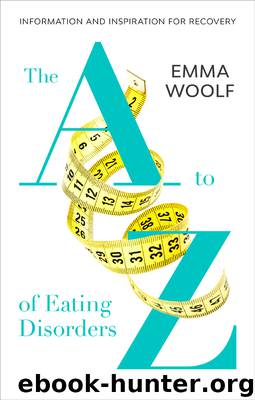The to Z of Eating Disorders by Emma Woolf

Author:Emma Woolf [Woolf Emma]
Language: eng
Format: epub
ISBN: 9781847094629
Publisher: SPCK
h
HAIR
Just like skin, nails and teeth, our hair is an outer sign of our inner health. The cells in every strand of hair need to be nourished with essential fats, protein and a variety of vitamins and minerals. Our so-called ‘crowning glory’ suffers greatly from crash dieting and poor nutrition: in those who are starving, hair becomes dry and brittle, and the scalp becomes flaky.
As hair is made of protein, this is one of the most important sources for making hair strong and healthy. Extremely low-protein diets may result in hair loss and thinning. Chicken, turkey, fish, dairy products and eggs are excellent sources of protein, along with vegetarian sources such as yogurt, cheese, legumes and nuts. Iron is also crucial for providing the roots and follicles of our hair with a rich blood supply. Vitamins A, C and E, omega-3 fatty acids, zinc and selenium are also essential for strong, shiny hair. Biotin is a water-soluble B vitamin found in foods such as wholegrains, liver, egg yolk, soya flour and yeast.
The good news is that hair grows quickly, and therefore responds rapidly to improved nutrition.
HEART
See CARDIAC COMPLICATIONS.
HOARDING
A compulsion that stems from the belief certain objects cannot be discarded because they might be needed later. While the term ‘hoarding’ is used casually in everyday life, in recent years hoarding has also been identified as a form of OCD. For many individuals, hoarding behaviour is strongly associated with their disordered eating. It is usually food hoarding, but also extends to general hoarding (see also KLEPTOMANIA). The correlation between disordered eating and hoarding tendencies is not entirely understood, but we know that serotonin dysfunction has been implicated in OCD as well as in anorexia and bulimia nervosa. Hoarding has often been noted in those with eating disorders and vice versa. The two disorders share key traits, including indecisiveness, anxiety, depression, social dysfunction and possibly genetic links.
HUNGER
Perhaps the most important aspect of recovering from an eating disorder is learning (or relearning) to listen and respond to your hunger. From birth, our body’s hunger signals are primal and elemental: they are essential to human survival. The problem comes when we mess with these hunger signals. As soon as we start dieting, start bingeing, fast intermittently, avoid certain foods or whole food groups, our body becomes confused. Chaotic overeating or restrictive undereating interferes with the natural cycle of hunger and satiety. As we have already seen (in DEPRIVATION and CRAVINGS), the more we deprive ourselves, the more we crave unhealthy foods. Similarly, the hungrier our body and brain become, the less able we are to make rational choices. By dieting or fasting, we risk losing control and bingeing on unhealthy ‘fast’ food, rather than making nutritious, balanced choices.
The notion that anorexic individuals are simply not hungry or have lost their appetite is incorrect (see also APPETITE). They are on the edge of starvation all the time, but they are very frightened of responding to that hunger. They fear that if they respond to their hunger by eating, they will never be able to stop.
Download
This site does not store any files on its server. We only index and link to content provided by other sites. Please contact the content providers to delete copyright contents if any and email us, we'll remove relevant links or contents immediately.
The Plant Paradox by Dr. Steven R. Gundry M.D(2038)
Heartstopper Volume 3 by Alice Oseman(1662)
Beauty Sick by Renee Engeln PhD(1498)
50 Ways to Soothe Yourself Without Food by Susan Albers(1399)
Mindful Eating by Jan Chozen Bays(1320)
Just Three Words (Soho Loft #2) by Melissa Brayden(1314)
Brave Girl Eating by Harriet Brown(1094)
The Archetype Diet by Dana James & Mark Hyman(1059)
Skin by Unknown(1058)
Women Food and God: An Unexpected Path to Almost Everything by Roth Geneen(988)
A Memoir of Anorexia and Bulimia by Wasted(960)
Brave Girl Eating: A Family's Struggle With Anorexia by Harriet Brown(955)
Wasted Updated Edition by Marya Hornbacher(947)
Hungry by Sheila Himmel(942)
Big Girl: How I Gave Up Dieting and Got a Life by Kelsey Miller(924)
Mothers, Daughters, and Body Image by Hillary L. McBride(921)
My Secret Life by Leanne Waters(909)
Unbearable Lightness: A Story of Loss and Gain by Rossi Portia de(878)
The to Z of Eating Disorders by Emma Woolf(856)
